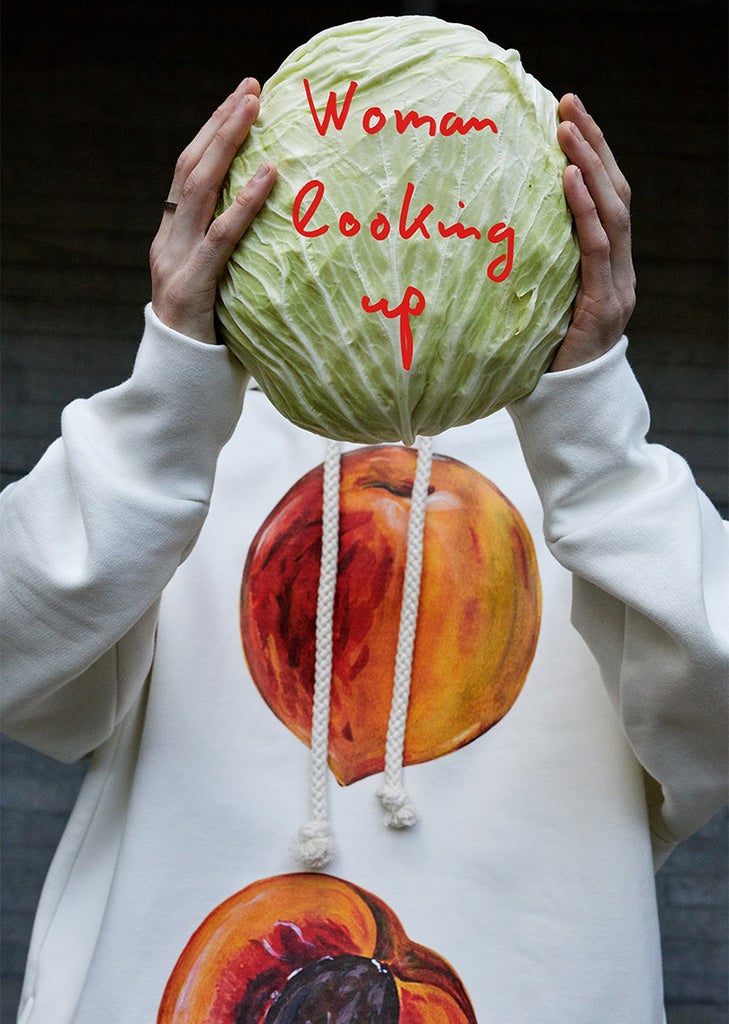
Actor Sophie Okonedo is dressed in head-to-toe white, holding a marrow the size of a bowling pin; a model wearing a jumper decorated with a drawing of a peach has her head hidden behind a big white cabbage, while a pair of leather mules shares a shot with a pine-green gourd. This is not a shoot from Gardeners’ World but from JW Anderson’s latest menswear collection, in which the clothes are shown alongside an allotment’s worth of vegetables; a harvest festival made fashion.
It’s not the first time a designer has fallen into the vegetable patch for inspiration. Of the current crop of collections, Alexa Chung’s features mushroom prints while Vetements has T-shirts decorated with cartoon cabbages and aubergines, bananas and pears. For SS21, Andreas Kronthaler for Vivienne Westwood went for a peach print on a top and London menswear designer Edward Crutchley put jewelled pomegranates on gowns and blouses.
Fruit and veg have proved popular backdrops for fashion shows, too. Offbeat New York brand Collina Strada not only dressed models in fruit prints for SS21 but pictured them among head-height tomato vines or green screens zooming in on the inside of a kiwi. At the brand’s SS20 show, where a model eating an orange dashed down the catwalk, guests were gifted produce while the show notes included tips on eating homegrown. Brands from Dolce & Gabbana to Rixo have set catwalks against a backdrop of vegetable-laden market stalls.
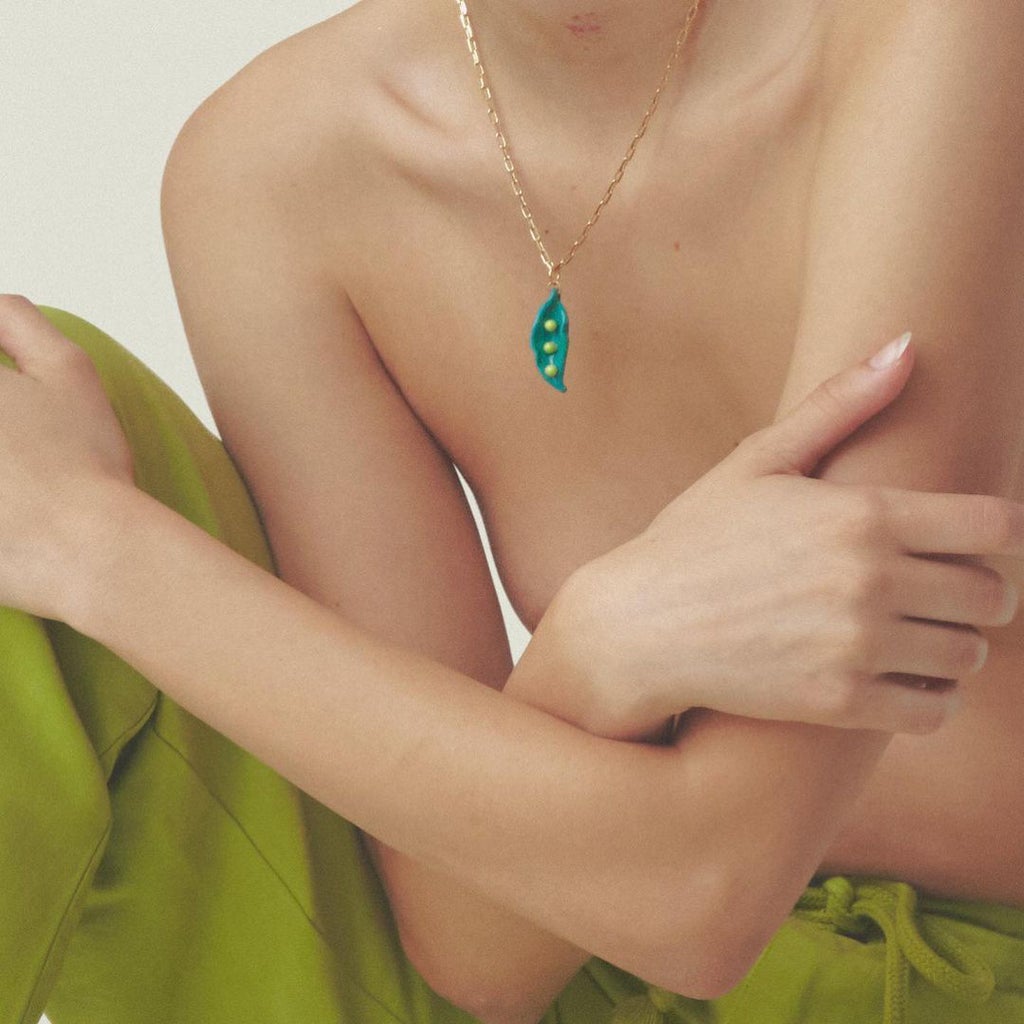
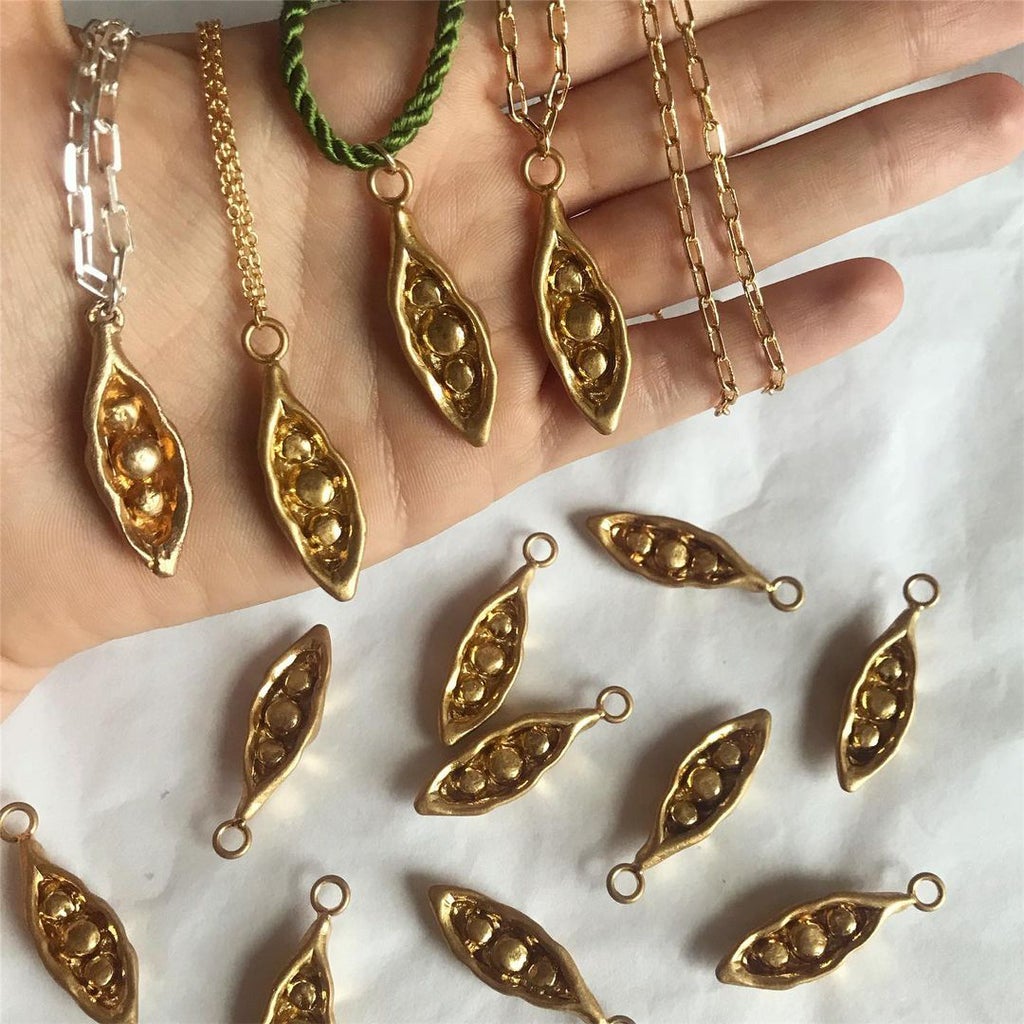
What is it about fruit and veg that designers find so inspiring? “They’re so much fun to work with,” says London-based jewellery designer Sandra Alexandra, who has built her brand on grocery-inspired trinkets, from the more expected – strawberries, cherries and watermelon – to pak choi, jalapeños and corn on the cob. They offer a rich and varied palette. “There are so many different shapes, colours and varieties that it’s an endless source of inspiration,” she says.
Guessing as to why Anderson went hard on the vegetables, behavioural psychologist Professor Carolyn Mair PhD, author of The Psychology of Fashion and founder of psychology.fashion, points out that they are easily recognisable and “as a result, make us feel comfortable”. There is a wholesomeness, too.
There is something inherently fun – and funny – about vegetables in a fashion context. Take the po-faced model with a leek sticking out of his pocket in another of Anderson’s campaign shots. The designer recently told Vogue: “I like this idea of humor in clothing. Squashes on jeans. A peach in the middle of a sweater. Something that makes you grin.”
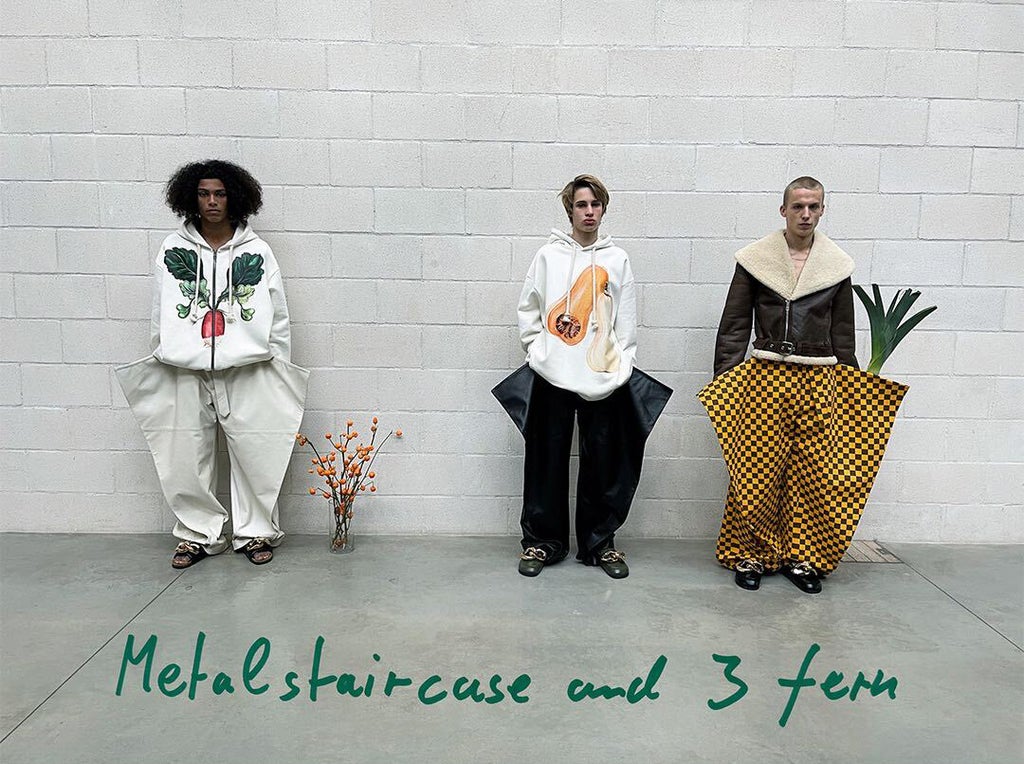
This exuberance is hitting the right note just now. “My jewellery is bright and colourful so I think people bought it to bring some joy into their lockdown life,” says Alexandra of the uptick in sales she has seen during the pandemic. “Wearing groceries-themed accessories helps people not to take themselves too seriously … during these uncertain times.”
Part of their current favour might also link to the more generalised health kick we are seeing off the back of the pandemic. A pair of courgettes dangling from your ears won’t make you healthier but just as certain vegetables hold symbolic meanings – beyond those bestowed on them by emoji – so wearing a vitamin-rich symbol could be read as talismanic, an aesthetic attempt to ward off ill health.
“Fruit and veg are a sign of life and are life-giving in that we need them to survive,” says Mair. She cites a 2019 study called “Lettuce Be Happy” which found that eating fruit and veg is associated with increased life satisfaction, with the effect more pronounced for veg than fruit.
During lockdown food has been a fraught topic, centred around the awful inadequacy of the government’s provisions for children on free school meals. But for those lucky enough, it has been a welcome diversion; the focus of many people’s days. “In the past year the most exciting part of many people’s week has been a trip to the greengrocer’s or the arrival on the doorstep of a fruit and veg box, and perhaps that’s alluded to in the work of some designers this season,” speculates Connie Karol Burks, assistant curator in the fashion department at the Victoria & Albert Museum. There’s been a spike in interest in gardening, too, and for those privileged enough to have the space, increased effort in growing their own.
There has also been more emphasis on connecting with nature. According to Burks, designers might use nature in their work as “a way of connecting ourselves to the world around us, or in some way harnessing the awe-inspiring elements of nature that humans are so struck by.”
It might seem a reach to link the current popularity of fruit and veg in fashion with wider global events but fashion as weathervane is nothing new. Burks, who was assistant curator of the V&A’s 2018 exhibition Fashioned From Nature, points out how “particular subjects come in and out of favour in a reflection of the predominant concerns and preoccupations of society at the time (for instance, motifs alluding to industry and machinery emerge in the 19th century).”
Burks also cites historical instances when certain produce found favour. Pomegranates, she says, “have a long history in textile design” and hold many symbolic meanings for different cultures and societies, including health, fertility, wealth, immortality and resurrection. Meanwhile pineapples, when they were first introduced to Europe “through exploration and colonisation … became incredibly fashionable, prized objects among the elite … symbol of wealth and supremacy.”
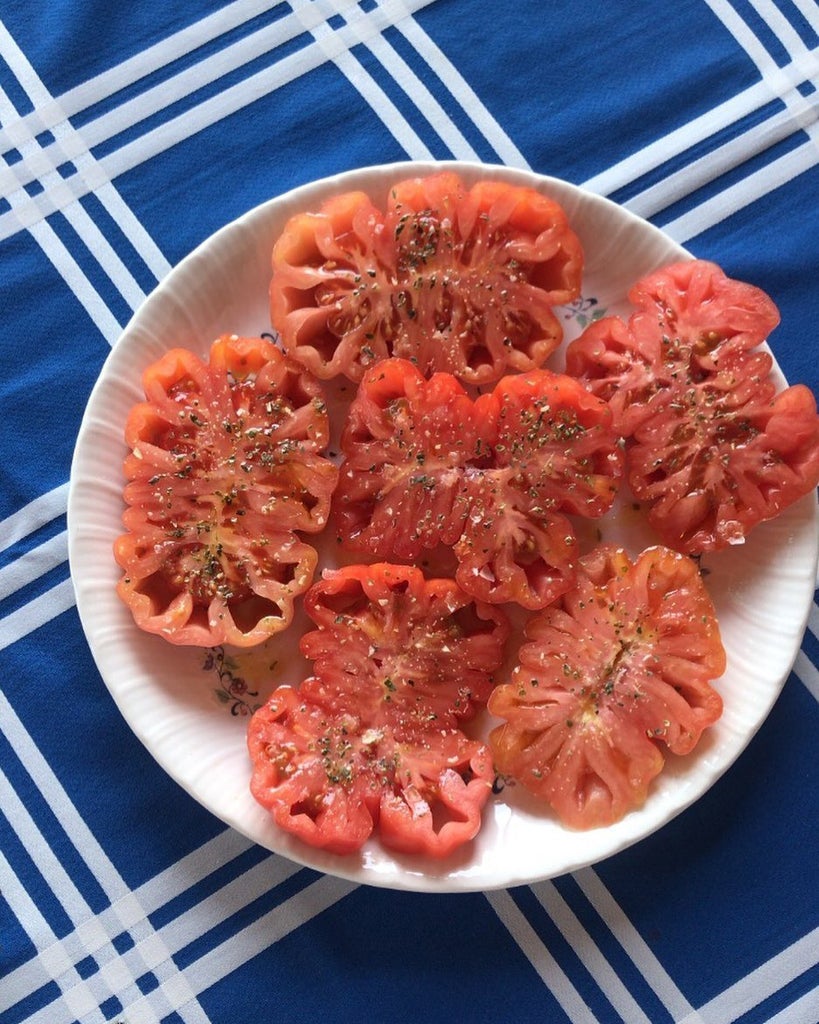
Shots of abundant fruit bowls and blue gingham tablecloths dotted with citrus fruits have become a staple among influencers rooting around for beauty in lockdown, a 21st century incarnation of the still life. Beyond the aesthetic, Burks highlights the transporting ability of fresh produce: “[It] can be so evocative of places and can prompt memories of past experiences, and with our ability to travel hampered at the moment, perhaps fruit and vegetables can remind us of past excursions and can take us to other geographies, in our minds at least!” Anderson’s marrows, Alexandra’s cherries and Collina Strada’s strawberries can at least feed our imagination.
Lockdown has prompted an exodus from cities but for those left behind there is cottagecore, a utopian vision of a bucolic life filled with lambs and very green grass. Fashion’s current preoccupation with your five-a-day could be read as an extension of this aesthetic and a hankering for a romanticised, rural lifestyle. “Designers often use their collection to pay homage to the things they appreciate. During the pandemic, many of us have had time to reflect and make changes to our priorities in terms of what’s important,” says Mair. “This has been further driven by the climate catastrophe. The idea of a simple life and living off the land can be appealing.”
The paradox is that many of these aesthetic references to the natural world are merely that – aesthetic. But with a continuing and increasingly urgent stress on sustainability in fashion, hopefully fruit and vegetable prints will cease to appear on polyester items and instead find their way onto more sustainable fabrics, many of which are actually made from fruit and vegetable waste, points out Burks – from Piñatex, which is made from the discarded leaves of pineapple plants, to Orange Fiber, a company making fabric from pulp and skins discarded by the fruit juice industry. “For many people today, the idea of wearing something that contains fibres from a plant (or fruit or vegetable) is much more appealing than wearing something made from fibres derived from petroleum,” she says.
Even if wearing a pair of pak choi earrings or a T-shirt with a peach on it doesn’t get you any closer to the earth, on a symbolic level these natural world references reflect the same wholesomeness that saw Animal Crossing have its pandemic moment, Junior Bake Off find a cult following among jaded TV viewers and cynicism drip away enough to allow for 82 million of us to be gripped by the bodice-ripping action of Bridgerton. During these strange, uncertain times, we’ll take our vitamins any way we can.
Like what you see? How about some more R29 goodness, right here?
Dungarees Are Your WFH Style Solution For 2021